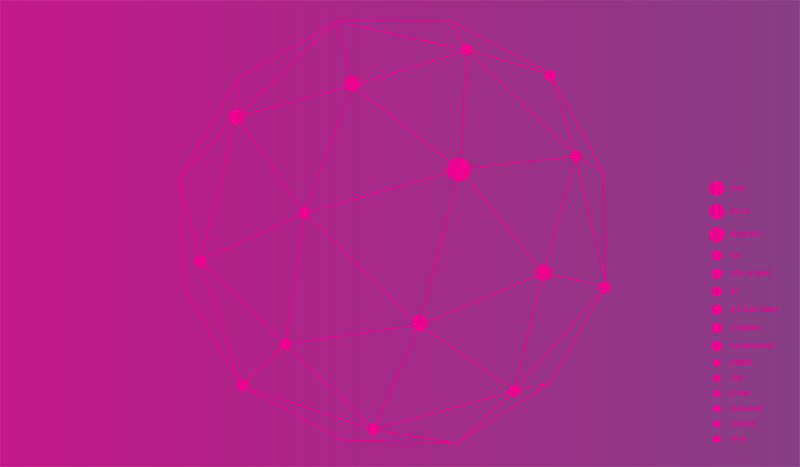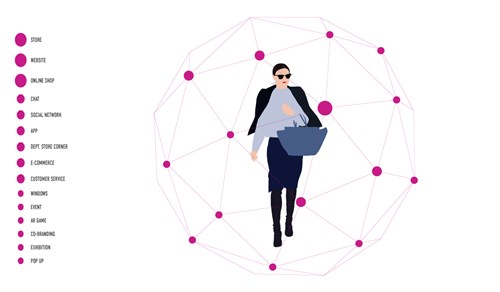CUSTOMER RETAIL EXPERIENCE | article | Monday, February 3, 2020
THE RETAIL EXPERIENCE CONSTELLATION MAP

Designing an attractive retail experience for consumers that is also profitable for companies has become an extremely complex task. Retail is in the process of transition. Long gone is the traditional paradigm whereby physical stores and e-commerce are priority touchpoints for customers and a main sources of profits. The time has come for the need to design a brand new and radically innovative retail experience that can cater to consumers’ current habits and expectations.
The new retail model integrates a constellation of various online and offline points, seamlessly connected, capable of generating an infinite number of interactions with the user, so that the relationship can be monetized in a global way. This system banishes the idea of tracing a handful of desirable customer journeys. On the contrary, it encourages users to create their own journey based on their immediate desires. It's not about how brands want to sell, but how people want to buy.
The new retail experience transforms the buying process into an emotional journey. Consumers’ desire for memorable, emotionally transformative and easily communicable experiences requires replacing the logic of story-telling with that of story-living. The journey will involve travelling through a constellation of touchpoints intersecting on different planes: human, physical and digital.
Let’s imagine a model with a constellation of experiences that form a sphere, surrounding the client who is at the center. The client can enter the constellation easily through one of the experiences and then circulate freely throughout. This “sphere” is always nearby, is flexible and dynamic and is present throughout people’s daily lives. The branded content permeates each element of the model giving meaning to the narrative as a whole.

 Based on the identity and objectives of each brand, this omnichannel system can include staff, stores, m-commerce, store windows, websites, chats, e-commerce, social networks, pop-ups, events, apps, mailings, corners in department stores, advertising, co-branding actions, public space interventions, specific customer services, among others.
Based on the identity and objectives of each brand, this omnichannel system can include staff, stores, m-commerce, store windows, websites, chats, e-commerce, social networks, pop-ups, events, apps, mailings, corners in department stores, advertising, co-branding actions, public space interventions, specific customer services, among others.
The customer journey cannot be linear since people no longer think or make decisions in a linear fashion. It must be designed as a network of experiences - some micro, others macro - that are inter-connected and allow users to navigate at their leisure (enter, circulate and exit) through those touchpoints specifically designed to adapt to the consumers’ needs and desires at that very moment. The journey configuration will resemble the logic of the book series "Choose your own adventure" whereby each chapter gives the option to continue through a different story based on the readers’ interest; or, to cite a more contemporary example, the interactive Netflix movie "Black Mirror: Bandersnatch" whereby viewers can choose the details of the plot, as well as choose between five endings based on their preferences and curiosity.
Designing retail experiences in a holistic way allows for the creation of diverse and complementary touchpoints that, far from overlapping and contradicting each other, manage to enrich the customer journey: in some cases people will be able to access the history of the brand, while in others they will only experience emotions indirectly associated to that story. There will also be touchpoints where customers can get advice, and others where they can purchase products. The important thing is that each point of contact provides only a fragment of the brand's universe, encouraging people to circulate throughout in order to understand the whole story. Moreover, this should ideally happen with the fluidity associated with postmodern thinking. Finally, each touchpoint should correspond to a level of engagement that is associated with the decision-making process: i.e. discovering the experience and raising awareness about it, stimulating consideration and desire, encouraging purchase and retaining the customer by developing their sense of brand loyalty.
The key will be: how do you attract the consumer to one of these touchpoints, like the rabbit hole that allows Alice to enter Wonderland, and how do you then allow for free and fluid circulation among points. A successful retail experience should encourage constant consumer navigation in order to create infinite interactions and multiple opportunities for engagement and monetization. Far from thinking that each touchpoint must have direct profitability, the commercial objective is that the retail experience, as a whole, is monetized in only some of the online / offline touchpoints.
The model can be enhanced by technologies such as Big Data, Artificial Intelligence and Emotional Engineering, in order to obtain a deep knowledge of the emotions involved, thereby not only shaping the design of the initial experience, but also giving the possibility of monitoring customers’ reactions in real time. This would allow for the reconfiguration of certain aesthetic and functional details within the journey if necessary, as well as the possibility of re-directing customers to other touchpoints that are more relevant to their needs and desires.
The need to integrate multiple touchpoints and channels poses a great challenge since it requires mastering a diversity of formats, contents, logics, interactions, aesthetics, technologies and functionalities, which in many cases result in static, tangled and inconsistent retail experiences. In addition, people’s desires, whims and demands are ever-changing and the demand to constantly create new and updated customer journeys is very high.
At The Sprout Studio we conceived a tool called “The Retail Experience Constellation Map”, which allows teams to design retail experiences from a holistic perspective. The tool helps teams devise powerful touchpoints, as well as the bridges between them that facilitate navigation and create a multiplicity of options within the same customer journey. It also shows you how to implement the idea of story-living within the entire retail experience, thereby enhancing it without losing its coherence.
In order to shape the most effective constellation it is important to define each touchpoint in terms of: a) the experience itself, including the type of interaction it will offer the user; b) the aesthetic and functional characteristics; c) the moment of contact (engagement phase): discovery, consideration, purchase, retention; d) the key message/s to communicate; e) the format (channel): physical, digital, human; f) the type of emotion generated in the interaction. Establishing the strategic relevance of each touchpoint will give the constellation a specific shape. Some will be nodal in the overall experience while others will function as transitions. The number of touchpoints will depend on the narrative and commercial objectives of each brand.
The design of the contact points is as essential as the design of the connections between them. The bridges must be attractive enough so that consumers want to cross them. This requires much more than merely establishing linear and simple links, such as "social network - online store" or "website – store”.
Consider the following example: a person could enter the constellation through an art installation in a public space. Imagine a hologram that depicts the inspiration behind a new fashion collection and allows for people to continue onto another touchpoint to obtain an additional fragment of the story, such as Instagram to see images and videos, a shop window to see a set design, a music platform to listen to a podcast, or registering via a website to receive an inspirational object at home. These touchpoints could all refer to each other, and lead to the continuation of the journey, unveiling other parts of the story, while connecting to the physical or virtual store. The inspirational object could be the key to accessing a special experience in the store, leading to the discovery of the new collection, all the while providing digital purchasing opportunities along the way. Key content in the podcast or in the window design could lead to a section of the virtual store with a retail gallery of exclusive items. The products purchased, whether in the physical or the virtual store, could be delivered at home with an olfactory packaging, an aroma that relates to the collection’s inspiration. This sensory packaging could also be the key to accessing exclusive website content revealing a new series of inspiring stimuli related to the products.
In summary, designing a complete retail experience means devising the multiple paths that the constellation allows for, thus generating different customer journey options based on users’ desires. Each person will have a different experience, so the relationship with the brand will also be more personal and intimate.
Download The Retail Experience Constellation Map Tool from this link: https://thesproutstudio.net/TheSproutRetail
